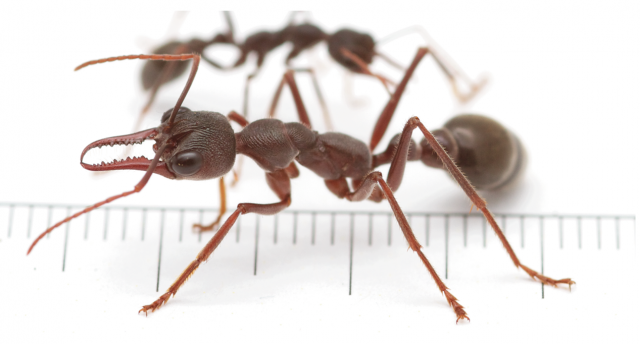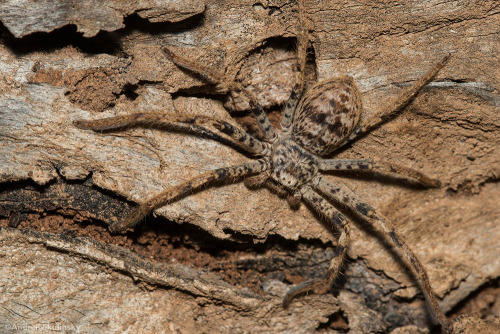Deadly enemies

Bulldog ants (Myrmecia pyriformis) are the most dangerous ants on Earth. The name of these Australian native ants is due to the way they bite and hang off their victims using their mandibles: they sink their teeth and they keep gnawing at it. These mandibles were used by the Australian natives to temporarily stitch wounds. Their venom is among the most toxic in the insect world and they have killed at least ten people since 1931 and many more have died from anaphylactic reactions if stung. They are characterized by their extreme aggression, ferocity and the extraordinary pain they inflict. Some of the smaller species are known as jumper ants since they aggressively jump towards their intruders.
Bulldog ants can be identified by their big size, more than 2,5 cm long, their large eyes, long slender mandibles (the strongest and lowest bone in the face), and the potent venom-loaded sting. They have often bright colors in shades of red and orange on the head or abdomen. They live underground in extensive tunnel networks, but their nest will typically be identified by a dirt mound (disturbing these mounds will result in a swarm of ants sent into a frenzy, resulting in someone being stung). To feed the colony, the ants collect nectar and other plant juices, as well as animal prey, which they carry back to the nest. Australia is home to around 90 species of bulldog ants, and they are found throughout the country in diverse habitats. They have excellent eyesight and are able to track or even follow intruders from a distance.
Myrmecia nests are located in the ground of Callitris forest, Eucalyptus woodland and forests, and wet and dry sclerophyll forests. The behavior of Myrmecia is particular. Workers have a similar size to queens, exhibit greater longevity than most workers from other species and are able to reproduce with male ants. Workers are solitary hunters and do not recruit other workers to food. They are considered one of the most primitive groups of ants still alive.

Delena cancerides is a social spider that is also endemic in Australia and it also inhabits the dry sclerophyll woodland. These Avondale spiders, also known as flat huntsman spiders, have been Hollywood stars. They appeared in the film Arachnophobia, where they «played» the deadly spiders invading a United States town. They were chosen by the producers partly because they are harmless to humans and so were safe to work with.1
Avondale spider colonies consist of a single female, the size of a palm, a width of 20 centimeters is normal (mostly legs though), and multiple cohorts of her offspring that remain in the natal nest until maturity (approximately one year). Colony size can reach 300 individuals, with typical sizes of 40-150. The female spider and her offspring only nest under the exfoliating bark of dead trees or similar well-protected cavities. 2 Eucalyptus species dominate the flora, yet few of them produce bark sturdy enough to serve as retreats for the Delena spiders, rendering suitable pieces of bark a rare resource since most possible bark refugees are not appropriate or are occupied. Spiders leave the retreat to forage at dusk, moving among the trees, and return at dawn. The bulldog ants have a similar foraging strategy: most workers make a single foraging trip per night, leaving the nest at twilight and lasting throughout the night and doing most of their foraging in trees. So both species are foraging and navigating to and from their nests at the same time. The spiders can feed on the ants and the ants have found a system to defend themselves from the spiders in this turf war, a «scorched earth» tactic.
Eric C. Yip from the Research School of Biology in the Australian National University and now in Cornell University found an interference competition between both species. Interference competition is when two species physically interfere with one another by aggressively trying to exclude the other from habitats or resources. This type of competition may lead to either coexistence or exclusion.
The researcher set up 132 nest boxes in the field and 120 of which were colonized by D. cancerides. 3Then, he waited to see what happened. Seven of these boxes (6%) were invaded by the bulldog ants over a 2-month period. Female spiders spend months maintaining the home while her offspring grow but when bulldog ants battle their way into the nest, their numbers and ferocity overwhelm the spider and she retreats with her young. In a couple of instances, the adult female was able to kill all the ants, but her offspring could not because their fangs could not puncture the ant exoskeleton. The surprising behavior was that the ants did not only eliminate the resident spiders, but they also actively destroy the spiders’ retreats, filling the boxes with debris (twigs, bark, and litter), rendering them useless to the spiders, and then they leave. The ants do not occupy the nest boxes; thus, interference occurs at a resource that is necessary to one species, the spider, but not to the other, the ant. None of the nest were reoccupied during the study. Avondale spiders need nests to live and suitable shelters are scarce, so losing one is a bad new. However, Eric Yip considers that ants are probably the underdogs «Spiders famously have a slow metabolism. That may give them an advantage, allowing them to survive while eating less. If the ants have a faster metabolism and thus need more food, having spiders around may pose a real threat to them. Their only option may be to drive the spiders out. A behavior that looks like an act of dominance may actually be one of desperation». (from ref. 1).
References
- Marshall M (2014) Zoologger: Ants fight dirty in turf war with spiders. New Scientist ↩
- Fang J (2014) Ants Use Scorched Earth Tactics Against Spiders. IFL Science September 19. ↩
- Yip EC (2014) Ants versus spiders: interference competition between two social predators. Insectes Sociaux 61(4): 403-406. DOI: 10.1007/s00040-014-0368-0 ↩
2 comments
[…] Posted in Noticias, Science, Biology | 0 comments […]
[…] En un rincón la hormiga más peligrosa del mundo; en el otro, una araña social estrella del cine de terror bichofóbico. Son enemigos mortales. José Ramón Alonso en Deadly enemies […]